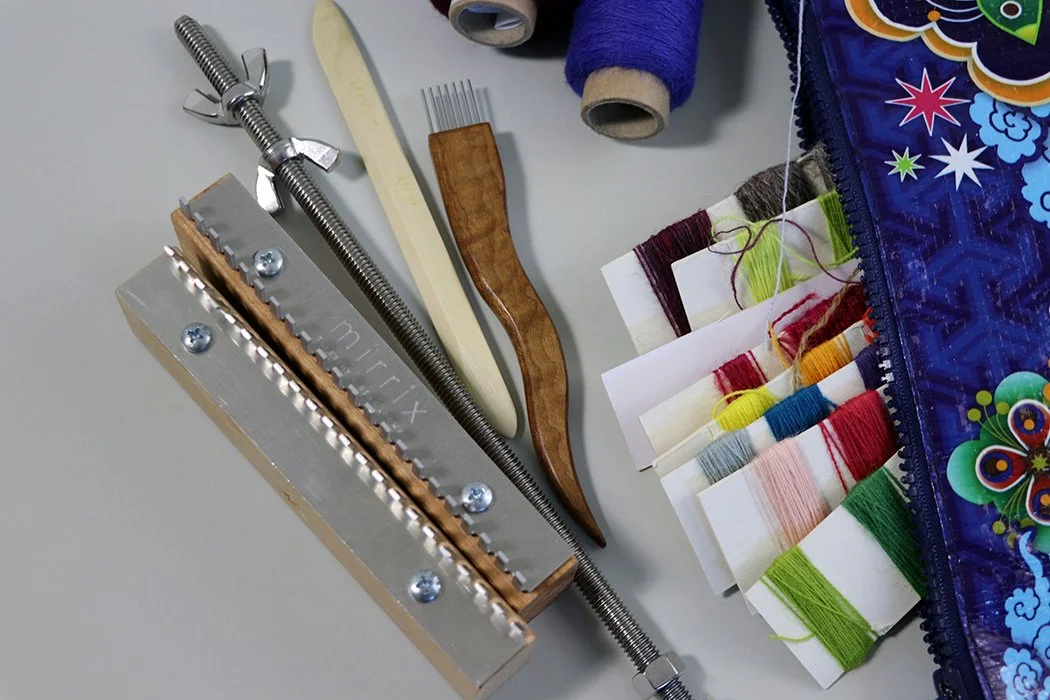I wrote a post a couple months ago about using shed sticks which included the few options that I could find readily available. Since then I’ve had several updates to the shed stick situation and I now have a healthy list of great options. I am quite sure there are more great tools out there. Here I was focusing on makers who have their work in stock all the time or at least with good consistency.* These are all US makers, but there are woodworkers all over the world and I am sure there are small tool makers in your neighborhood also if you do not live in the US.
Messing around with looms and yarn, Part 2
Who else is a loom geek? I really enjoy trying out different pieces of equipment and though I’d love to try every large tapestry loom, mostly I’m testing small looms that I have the space for (or not!). Last week I talked about this new-to-me loom I’m playing with from weaversbazaar in the UK. I’ve had a wonderful time picking the shed and trying out the WB heavy 5/2 wool. You can read about that HERE. I wanted to share a bit more about the clamps that are holding the loom and try them with a couple other looms I like.*
Messing around with looms and yarn: playing with wool and wood
I’m constantly experimenting with tools and yarn and techniques in tapestry weaving. It gives me a lot of joy and though the outcomes of these experiments is sometimes unpleasing, the process is always educational and more ideas surprise me with their success than not. Lately I’ve been working on a loom that weaversbazaar in the UK sells. It is a simple tensioned frame made by Andrew Dickinson.*
The beauty of a tensioned frame loom.
Tension is the friend of a tapestry weaver. At least it is for me. I do know some tapestry weavers who love a floppy warp and who weave very large things on wooden non-tensioned frames that have nails on the edges. I admire their ability to manage the weave with non-tensioned equipment at such a large size! But for me, a loom with some tensioning ability is the best.
The Little Guy Grows!
I wrote a blog post last year about loom length and how it impacts tapestry weaving. The post is called Questions from the Book: Ease of Weaving and Loom Length. In that post I advocated for longer looms and more free warp because it really makes weaving easier no matter what loom you’re using. See the post for details about why I feel this way.
Since that post, the one Mirrix loom that I have struggled with a bit because it felt like the warp was too short has had an upgrade. (Admittedly this is just my preference and the original Little Guy loom works just perfectly as it is!) You can now get the Little Guy loom in the Tall Guy version. The new loom adds inches to both the threaded rod and the copper pipe making the overall maximum height of the loom 5 inches longer.
Finding the right shed stick for weaving tapestry on small looms
I have used shed sticks made by Jim Hokett for my whole little looms weaving career. So when he retired in 2019, I was sad to lose this source of wonderful tools. There are other people making similar looms, but I have struggled to find a replacement for his shed sticks.
Today’s video does a deep dive into this humble tool. Shed sticks are particularly useful on small tapestry looms without shedding devices. I use them as a simple way to open the shed, prevent abrasion of my weft yarn, and to check my shed for errors. And on narrow setts, they can pick up warps that my fingers cannot.
What tools and materials do I need to learn tapestry weaving?
Learning a new art or craft can mean that you need to purchase some supplies. The hard thing is knowing what you actually need when there are so many options. Below is a list of equipment and yarns which I’ve seen be very successfully used by beginning tapestry weavers. Some people will use the same materials for their whole weaving career!
Questions from the Book: Ease of weaving and loom length
What does loom length have to do with it?
Many of you are now working through my book, The Art of Tapestry Weaving, and I’ve been answering some of your questions here on the blog. One recent question from Zach was about how much warp you need to leave for various finishing techniques on the Mirrix Saffron loom. This question got me thinking about loom length and the video below was the result.
Loom length is something that I don’t hear tapestry instructors talking about a lot. Those of us who have been weaving for a long time intuitively understand the limitations of a short warp. But for new weavers, it isn’t something you’d automatically think about.







